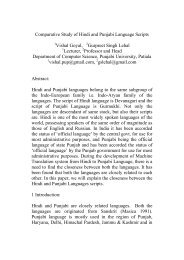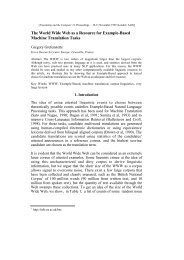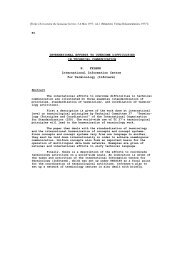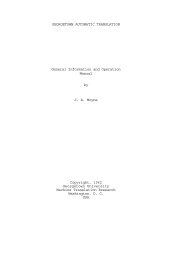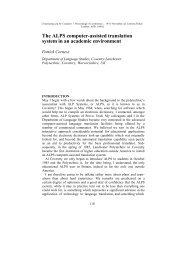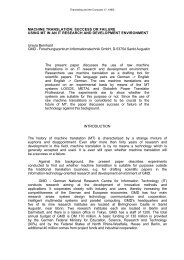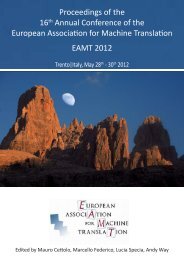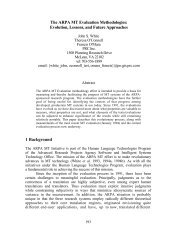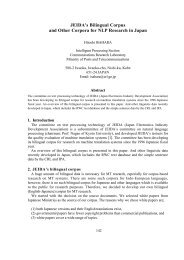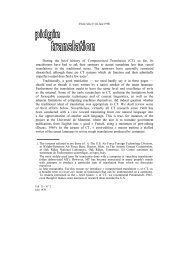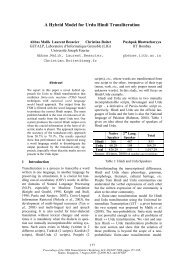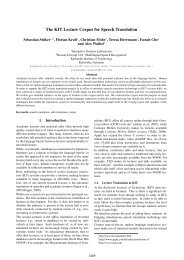Controlled authoring at SAP - Machine Translation Archive
Controlled authoring at SAP - Machine Translation Archive
Controlled authoring at SAP - Machine Translation Archive
Create successful ePaper yourself
Turn your PDF publications into a flip-book with our unique Google optimized e-Paper software.
4 Future Plans<br />
The DFKI/acrolinx are interested in providing new clients and languages and in improving terminology,<br />
grammar and style checking. <strong>SAP</strong> are looking for a successful implement<strong>at</strong>ion and rollout<br />
(consolid<strong>at</strong>ion of position) before expanding the project further. Although there are plans afoot for new<br />
text types, clients and additional languages. The current development plans include:<br />
• an optimis<strong>at</strong>ion in the performance and scalability of the client and server components<br />
• an expansion of the terminology component to support OLIF and a larger number of subject<br />
areas<br />
• an improvement in reporting and b<strong>at</strong>ch job processing<br />
• an upd<strong>at</strong>e for the background linguistic resources.<br />
These developments will be undertaken by DFKI and acrolinx as part of the SKATE maintenance<br />
agreement with <strong>SAP</strong>.<br />
5 Conclusions<br />
During the SKATE project, the <strong>SAP</strong> members of the development team were always very careful to<br />
avoid the phrase "<strong>Controlled</strong> Language" with all of its possible neg<strong>at</strong>ive connot<strong>at</strong>ions. To encourage<br />
acceptance of the SKATE tool within <strong>SAP</strong>, it was always described as a "text enhancement" or even a<br />
"quality enhancement" tool. Experience so far has shown, however, th<strong>at</strong> these fears were entirely<br />
misplaced. Acceptance of SKATE <strong>at</strong> <strong>SAP</strong> is widespread on all levels (management and users) and<br />
resistance has not been experienced so far. Even though rollout has not been completed, various<br />
internal organiz<strong>at</strong>ions describe SKATE as an integral part of the quality assurance process for<br />
document<strong>at</strong>ion and include the software as an important part of future plans, and most potential users<br />
want to get their hands on it. The economic situ<strong>at</strong>ion and the constant pressure to reduce costs and<br />
time-to-market have apparently overtaken all the fears of being "controlled". It may also be th<strong>at</strong> regular<br />
st<strong>at</strong>us meetings, and the publishing of the testing results have already made people feel more<br />
comfortable with the idea. Wh<strong>at</strong>ever the reason, it cannot be denied th<strong>at</strong> management support on all<br />
levels is absolutely essential for the successful development and introduction of new tools as is the<br />
necessary technical infrastructure.<br />
If we had to invent/design the SKATE LCS all over again, then usability issues would appear earlier on<br />
the agenda. These issues became much more important than we expected <strong>at</strong> the beginning of the<br />
project.<br />
Depending on the profile of the user, there are different perceptions of quality. With the SKATE tool,<br />
however, we believe th<strong>at</strong> we have a tool th<strong>at</strong> we can use to system<strong>at</strong>ically check large volumes of<br />
document<strong>at</strong>ion to start producing reliable quality benchmarks for the first time. <strong>SAP</strong>'s<br />
Standards&Guidelines and existing human quality checks can only sustain and support this endeavour<br />
and we expect a gre<strong>at</strong> deal of synergy between the two processes.<br />
6 Bibliography<br />
Brants, T. (2000), TnT - A St<strong>at</strong>istical Part-of-Speech Tagger", in Proceedings of the Sixth Applied<br />
N<strong>at</strong>ural Language Processing Conference ANLP-2000, Se<strong>at</strong>tle, WA, 2000.<br />
Bredenkamp, A., Crysmann, B. and M. Petrea (2000), "Looking for Errors: A declar<strong>at</strong>ive formalism for<br />
resource-adaptive language checking", in Proceedings of the 2nd Intern<strong>at</strong>ional Conference on<br />
Language Resources and Evalu<strong>at</strong>ion, Athens, Greece.<br />
Duden 9 (1997), "Duden, Richtiges und gutes Deutsch: Wörterbuch der sprachlichen Zweifelsfälle",<br />
Wissenschaftlicher R<strong>at</strong> der Dudenredaktion, 4. Auflage, Dudenverlag, 1997.<br />
Hargis, G. (1998), "Developing Quality Technical Document<strong>at</strong>ion", chapter "Words to W<strong>at</strong>ch for<br />
Clarity", Prentice Hall, 1998.<br />
McCormick, S., Lieske, C. and G. Thurmair (2001), "The Open Lexicon Interchange Form<strong>at</strong> Comes of<br />
Age", in Proceedings of the MT-Summit VIII, Santiago de Compostela, Spain, 2001.<br />
(http://www.olif.net/olif2/documents/olifMtSummitVIII.pdf)<br />
Petitpierre, D. and G. Russell (1995), "MMORPH - The Multext Morphology Program", Multext<br />
deliverable report for the task 2.3.1, ISSCO, University of Geneva, February 1995.



